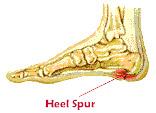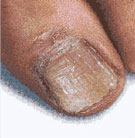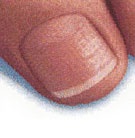Heel Pain
Having a spur does not make a difference in diagnosing or treating heel pain. It is simply a good indicator of the longevity of the problem and confirms the severity of the underlying biomechanical problem causing it.
Heel pain, plantar fasciitis or heel spur syndrome is caused by an
abnormal and excessive pull of the plantar fascia at its insertion.
Morning pain and pain after periods of rest is characteristic
and can progress to pain all the time. Treatment is
aimed at shrinking the bursal sac via strapping,
NSAID's, injection and orthotics. If this fails, treatment can
be rendered via endoscopic plantar fasciotomy, in which a
pencil thin camera is placed into the heel soft tissue to release the fascia.
New Treatment For Fungus Toenails Onychomycosis
After years of testing, there are new oral medications that
have been found to be both effective and safe. They are
well-tolerated and extremely effective on chronic skin and
nail fungal infections. It takes about 6-12 months for the nail
to clear up. About 71% of patients are cured.
Athlete's Foot
Tinea Pedis
These are caused by fungus that resides in the skin (tinea pedis) or nails (onychomycosis). This infection, if left untreated can blister and cause a break in the skin leaving you susceptible to a bacterial infection. In its early stages, the redness and itching can be treated with topical creams and liquids.
In more severe cases, oral medication is required. In the most severe cases nail removal, followed by oral and topical medication, more often then not can be used to treat this problem.
Pediatric Foot Problems
In-toe, Outtoe & Overlapping Toes
The most common foot problem seen in children is in-toe. Often times this is the result of lack of external rotation at the hip (femur). The result is in-toe gait and a flattening of the arch.
Although many of the deformities seen in the infant are a result of retained intrauterine position, the child will grow out of these if the intrauterine position retained is significant, or a structural deformity is present these problems will not be resolved. The earlier treatment is started, the more successful resolution can be.
Ankle Sprains
Inversion sprains occur when the foot turns in and one of the three ligaments on the outside aspect of the ankle strain or rupture. The severity of the strain dictates the treatment.
A mild strain or sprain is treated by immobilization, non weight-bearing and anti-inflammatories and is followed by re-training and strengthening. Proper treatment is essential to prevent recurrence and chronic sprains.
Geriatric Foot Problems
The geriatric patient has many of the same foot problems as the younger patient but their condition is often complicated by poor circulation, arthritis, bursitis, neuritis or other inflammatory conditions.
Your feet should not hurt because you are older. Many of your conditions can be alleviated by modern foot care.
Foot Odor
Foot odor is caused by the bacterial decomposition of excessive perspiration on the soles of the feet and between the toes. The warm, moist environment inside your shoes promotes the bacterial growth on your feet.
Treatment of your feet is usually directed at controlling the sweating. Stubborn cases may be treated by your podiatrist with prescription medicines.
Arthritic Foot Conditions
Rheumatoid arthritis and osteoarthritis are two common forms of arthritis that affect millions of Americans, especially those over age 45. Rheumatoid arthritis affects the entire body whereas osteoarthritis is isolated to the joints.
Surgery to reconstruct the joint may be needed if arthritis causes chronic problems that cannot be controlled by medication, orthotics or physical therapy.
Foot and Ankle Fractures
A fracture (break) of your ankle usually happens due to a fall, an accident or hard blow. There are different types of fractures that occur depending upon the severity of the injury. Spiral, hairline, open and crushed bones are names used to describe fractures.
Our doctors are experts in fracture care and will perform x-rays to determine the type fracture you have. We sometimes need to realign the bones, this is done through a process called reduction. Casting of the fracture, a walking boot, brace or splint are used to hold the bone in place during healing.
Diabetic Foot Problems
Most of the problems diabetic patients have with their feet are as the result of either nerve damage (neuropathy), infection or poor circulation. Deformities of the foot and trauma to the foot also play a part in causing sores and infections.





